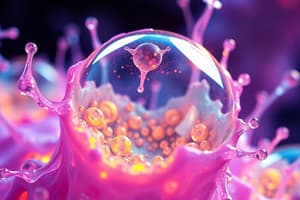Podcast
Questions and Answers
What is the primary characteristic of brightfield illumination?
What is the primary characteristic of brightfield illumination?
- Dark objects are visible against a bright background. (correct)
- Objects appear bright against a dark background.
- Light is reflected off the specimen entering the lens.
- It uses a special filter to enhance colors.
In dark field microscopy, what allows the organism to be visible?
In dark field microscopy, what allows the organism to be visible?
- The use of colored dyes that enhance visibility.
- Transmitted light from a bright field.
- Only the light reflected from the specimen enters the objective lens. (correct)
- Light passing directly through the background.
Which type of microscopy would you use for live microorganisms that cannot be stained?
Which type of microscopy would you use for live microorganisms that cannot be stained?
- Confocal microscopy.
- Phase contrast microscopy.
- Dark field microscopy. (correct)
- Brightfield microscopy.
What component is used in dark field microscopy to block direct light from the source?
What component is used in dark field microscopy to block direct light from the source?
In brightfield microscopy, what happens to the light reflected off the specimen?
In brightfield microscopy, what happens to the light reflected off the specimen?
What visual effect does dark field microscopy provide compared to brightfield microscopy?
What visual effect does dark field microscopy provide compared to brightfield microscopy?
What is one limitation of staining organisms for microscopy?
What is one limitation of staining organisms for microscopy?
What is the outcome of using brightfield illumination on transparent specimens?
What is the outcome of using brightfield illumination on transparent specimens?
What type of microscopy is specifically useful for examining unstained microorganisms suspended in liquid?
What type of microscopy is specifically useful for examining unstained microorganisms suspended in liquid?
Which microorganism is identified as the causative agent of syphilis in the context of dark field microscopy?
Which microorganism is identified as the causative agent of syphilis in the context of dark field microscopy?
What advantage does phase contrast microscopy provide when observing living microorganisms?
What advantage does phase contrast microscopy provide when observing living microorganisms?
In phase contrast microscopy, how are the two sets of light rays formed?
In phase contrast microscopy, how are the two sets of light rays formed?
What does not need to be performed on specimens when using phase contrast microscopy?
What does not need to be performed on specimens when using phase contrast microscopy?
What is the process of diffraction in relation to light microscopy?
What is the process of diffraction in relation to light microscopy?
How does differential interference contrast microscopy differ from phase contrast microscopy?
How does differential interference contrast microscopy differ from phase contrast microscopy?
What type of microscopy presents specimens as light against a dark background?
What type of microscopy presents specimens as light against a dark background?
Flashcards are hidden until you start studying
Study Notes
Brightfield Illumination
- In brightfield illumination, dark objects stand out against a bright background.
- Objects observed appear dark due to light being reflected off the specimens that do not enter the objective lens.
- This microscopy technique reveals internal structures and outlines of transparent particles.
Dark Field Microscopy
- Dark field microscopy allows light objects to be visualized against a dark background, the opposite of brightfield.
- Only light reflected off the specimen enters the objective lens, enabling clear visibility without background interference.
- Ideal for observing live microorganisms that are either unstained or distorted when stained.
- Uses a dark field condenser with an opaque disc to block direct light; only scattered light from the specimen is captured.
- Particularly useful for examining thin spirochetes, such as Treponema pallidum, the causative agent of syphilis.
Phase Contrast Microscopy
- Enhances the contrast of internal structures within living microorganisms without the need for staining or fixing.
- Operates by using two sets of light rays: direct rays from the light source and diffracted rays that interact with specimen structures.
- Creates images with varying light intensity, presenting shading effects that highlight different cellular features.
Differential Interference Contrast Microscopy (DIC)
- Similar to phase contrast but utilizes two beams of light and differences in refractive indexes for enhanced imaging.
- Produces three-dimensional-like images through the use of prisms to manipulate light paths, improving detail and contrast.
Summary of Light Microscopy Techniques
- Differential methodologies exist for visualizing microscopic structures, each tailored for specific observations based on specimen characteristics and lighting techniques.
- Understanding the distinctions among brightfield, dark field, phase contrast, and DIC microscopy is critical for accurately identifying and studying microorganisms.
Studying That Suits You
Use AI to generate personalized quizzes and flashcards to suit your learning preferences.




